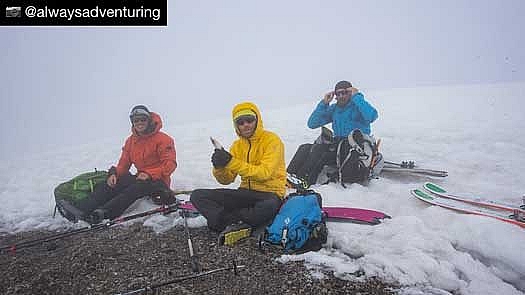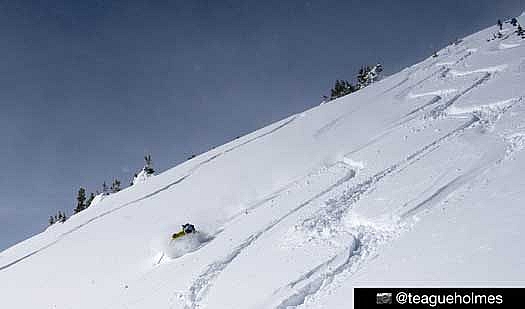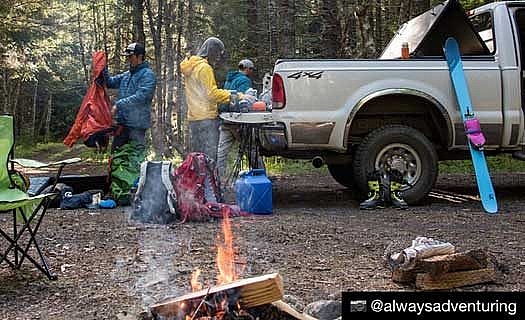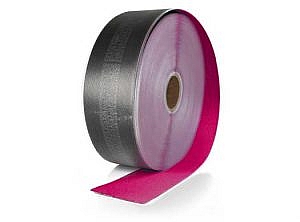Post sponsored by Cripple Creek Backcountry, now with three locations in the Colorado Rocky Mountains.

The Race Pro 2.0s gripped their way up soggy conditions in the Worm Flows then doubled as a dry seat on the crater rim of Mt Saint Helens, Oregon.
The battle to shave weight in ski touring gear rages on. Case in point: one of the biggest ski mountaineering lines in history was conquered this past fall in four buckle Tecnica boots. Jim Morrison and Hilaree Nelson climbed to the 27,940 foot summit of Lhotse, and skied the Lhotse Couloir in the impossibly light 1,300 gram Tecnica Zero G Pro Tour. A similar boot just a few years ago would have weighed significantly more.
There is however another factor of physics to consider in ski touring: friction between climbing skin and snow. Yes Wildsnow readers, let us take a break from our attempts to defy Newton and shift our focus to DaVinci and Amontons.
Different compositions of skin plush materials yield surprisingly different results in grip and glide. Climbing skins were originally a repurposing of the hide from a successful seal hunt. I’ve spoken with a guy who is ancient enough to have actually used “seal skins,” he says they “glide like crazy.” Of course, we won’t ask seals to sacrifice their lives for our skis, so enter modern skin plush.
Mohair, sourced from the fur of Angora goats, and Nylon are the two predominant materials used for climbing skin plush, with a 70% mohair / 30% Nylon blend being the current gold standard. (There are other types of skins, that use mechanical grip patterns and that sort of thing, I don’t cover those here.)
Modern ski mountaineering race skins are composed of 100% Mohair, which has less friction (but consequently lower grip) than Nylon. Race (and all) skins are then backed and treating in different ways to improve water-repellency and durability. Race skins not only glide much better, but are built with weight in mind. The end result is a faster gliding, lighter skin that is also thinner and packs up better.
If lightweight mohair builds are grippy enough for the spandex clad uphiller dragging a mere 59mm to 62mm of skin width uphill, said benefits should scale up proportionally in a an offering, for wide skis,yes?
Pomoca, a leading manufacturer of climbing skins, and my favorite, now offers their Race 2.0 skin in a 120mm width. Any specialty Pomoca retailer can get a roll of the wide race plush which can be cut to length and fastened with tip and tail attachments of your choice. They also have a universal length that come with the standard Pomoca tail clip sewn on, and a tip attachment you install after the skin is cut to the ski’s length.
I became convinced that a pure mohair race plush would be plenty grippy after spending time zipping around on 62mm Pomoca Race 2.0 skins. So last season I rigged a pair of Race 2.0’s cut from a 120mm wide roll, book ended with Black Diamond tip and tail attachments. These skins were cut to fit both my DPS Wailer 106 Tour1 skis as well as my full rocker Dynafit Beast 108s.

Race Pros helped me keep up on this multi lap day with a fast crew. Efficiency leads to more powder in the face! Ten Mile Range, CO
Glide was the main impetus for my experiment, and the primary benefit. In flat sections of a tour, my kick and glide is longer with less effort than that of ski partners dragging nylon or mo-ny mix. Flat portions of a long climb offer a reprieve for all skiers, and with pure mohair that “break time” is exaggerated with the fast skins. On steeper climbs I keep my skis on the ground more than I used to, making for a more efficient stride which fully utilizes modern touring gear.
Packability is another bonus with the Race Pro’s, especially in colder temps when I keep them in my coat during the descent, to preserve tack. The weight reduction is noticeable as well, but not drastic. And Pomoca’s standard glue compound is in my opinion the best on the market (it is used on the Race 2.0s).

Setting up camp, the Race Pros not bothered by being abused and left glue-to-glue for many days in the back of the truck. Mt Saint Helens, Oregon.
Durability and less grip are the main drawbacks to consider when choosing race plush over nylon compositions. After 60 or so days on the Race Pro 2.0s I did not notice much mohair loss, just a touch around the edges. The amount of firm or frozen snow this plush sees in a race application wears them out more quickly than powder ski-touring. I did have a tear around a rivet of the tail attachment, which would have been avoided had I chosen the Back Fix version which is sewn on.
In terms of grip, the 38g/cm2 of pressure from the Race Pro 2.0s is more than enough grip for any powder scenario, and many spring snow conditions. I only noticed limitations while skiing the rockered Beast 108s on a well traveled or frozen slick skin track.
Last spring I was dealing with an inflamed IT band during a PNW volcano tour. I reluctantly opted to pull out the light powder ski rig with the race skins to ease the burden on said leg. The plush handled the soggy, almost frozen ascent and even the barely frozen summit quite well, giving me added faith in their climbing prowess. Using a skin like this is probably best for powder scenarios and skiers with touring experience.
Tune into any ski movie featuring British Columbia freeriders ski touring and you may notice the pink glow of Pomoca’s Race 2.0 plush as they make their way up tricky pillow lines. Skiers such as Chris Rubens and Eric Hjorleifson are Pomoca athletes that will run the race plush on their twin rocker 115mm plus waisted powder skis. The weight savings and gliding efficiency save time and energy for what really matters. Furthermore, the width of a modern powder ski puts so much carpet on the snow that synthetic plush is overkill in powder conditions. While I’ll never send like those guys, I can attest to the fact that the Pomoca Race 2.0 skin is not just for racing anymore.
(Wildsnow guest blogger Gary Smith is an avid backcountry skier and ski mountaineer residing in Eagle County, Colorado. Visit @ghostrider.gary on Instagram for ski shots and snippets of mountain life.)
On March 22nd 2021, Gary Smith tragically died in an avalanche outside of Beaver Creek Resort in Colorado. Since 2018, Gary has been a frequent and insightful contributor to WildSnow. From Christmas Eve spent at the Wildsnow Field HQ cabin, to testing gear and sharing his love for steep skiing around the world, he was a pillar of the ski touring community and will be greatly missed.

